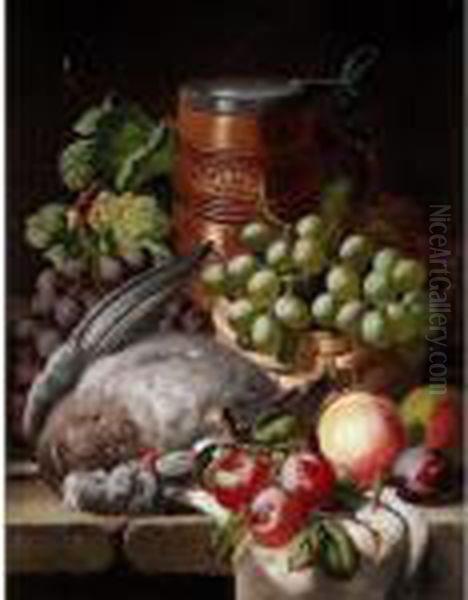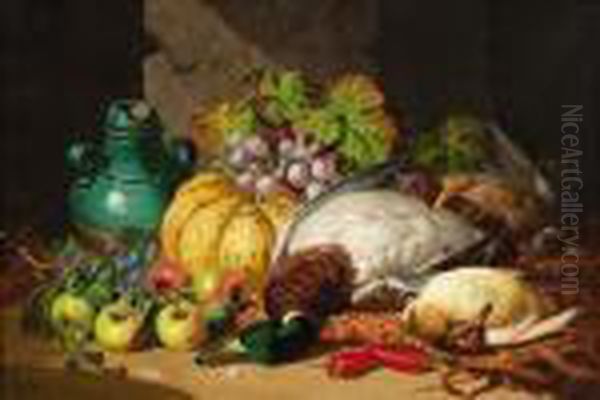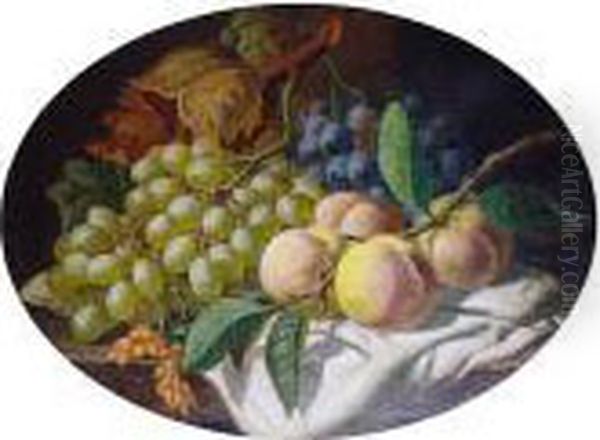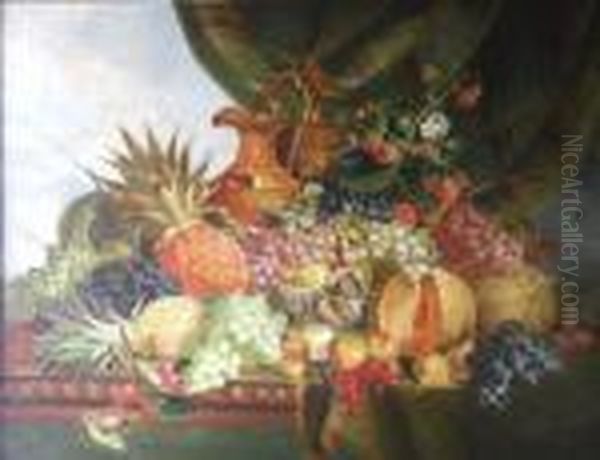The annals of art history are rich with celebrated figures whose lives and works have been meticulously documented. Yet, alongside these luminaries exist countless artists whose contributions, while perhaps less heralded, form an integral part of the cultural tapestry of their time. Charles Thomas Bale, a British artist active during the latter part of the nineteenth century, appears to fall into this category. While detailed biographical records remain elusive, his work, particularly in the genre of still life, offers a window into the artistic sensibilities and cultural currents of the Victorian era. His paintings, often featuring arrangements of fruit and decorative objects, engage with long-standing traditions while reflecting contemporary tastes, notably the period's fascination with exoticism.
The Enduring Tradition of Still Life
The genre of still life, focusing on the depiction of inanimate objects, boasts a long and distinguished history in Western art. It rose to prominence, particularly in Northern Europe during the Dutch Golden Age of the seventeenth century. Artists like Willem Claesz. Heda and Pieter Claesz achieved extraordinary levels of realism in their portrayals of banquet tables laden with food, glassware, and metalwork. These works were not merely displays of technical virtuosity; they often carried complex symbolic meanings, reflecting on wealth, transience, and morality – the vanitas theme being particularly prevalent.
In Spain, artists such as Francisco de Zurbarán brought a stark, meditative quality to the genre with his austere arrangements of simple objects. Later, in eighteenth-century France, Jean-Baptiste-Siméon Chardin elevated humble domestic scenes and still lifes to a level of profound sensitivity and painterly beauty, influencing generations of artists. The appeal of still life lies in its potential for focused study of form, light, texture, and composition, allowing artists to explore the material world in intimate detail while often embedding deeper layers of meaning. It remained a vital genre through the nineteenth century, adapted and reinterpreted by artists across various movements.
Bale and the Victorian Still Life

Charles Thomas Bale appears to have found his niche within this enduring tradition, specializing in the meticulous depiction of still life arrangements. Active roughly between 1866 and 1892, his period of activity places him firmly within the late Victorian era in Britain, a time of significant industrial, social, and cultural change. Artistically, it was a period of diverse trends, ranging from the lingering influence of the Pre-Raphaelites to the rise of the Aesthetic Movement and the gradual infiltration of Impressionist ideas from across the Channel.
Within this context, still life painting continued to be popular, both for domestic decoration and as a subject for academic study and exhibition. Bale's focus on fruit and decorative items aligns with common themes in the genre. His works likely appealed to a market that appreciated technical skill and the depiction of abundance and refinement. One specific work often associated with him provides a focal point for understanding his artistic concerns: Still Life of Pears, Apples, Grapes and a Chinese Jar.
A Closer Look: Still Life of Pears, Apples, Grapes and a Chinese Jar
While images and detailed provenance for this specific painting may not be widely accessible, its title alone suggests a composition typical of late nineteenth-century still life. We can envision an arrangement likely featuring a variety of fruits, chosen perhaps for their contrasting shapes, colours, and textures. Pears, apples, and grapes were common subjects, allowing the artist to demonstrate skill in rendering the soft sheen of pear skin, the firmer blush of an apple, and the translucent quality of grapes, often depicted with a delicate bloom.
The inclusion of a "Chinese Jar" is particularly significant. This element immediately introduces a note of exoticism and sophistication. Such objects, imported from East Asia, were highly fashionable in Victorian Britain, collected and displayed in affluent homes. For the artist, the jar would present distinct technical challenges: capturing the smooth, often reflective surface of the porcelain, depicting any intricate patterns or glazes accurately, and integrating its form harmoniously within the overall composition alongside the more organic shapes of the fruit. The interplay of light on these different surfaces would be crucial to creating a convincing and visually engaging scene.
Layers of Meaning: Symbolism in Still Life
Still life paintings are rarely just about the objects themselves; they often carry symbolic weight, drawing on established conventions or introducing new interpretations. In the context of Bale's Still Life of Pears, Apples, Grapes and a Chinese Jar, the chosen elements could be imbued with various meanings, potentially creating a dialogue within the composition. Fruit, for instance, is rich in symbolism. Grapes have long been associated with abundance, pleasure, and, in Christian iconography, the Eucharist.

Apples carry complex connotations, famously linked to the biblical story of the Fall, representing temptation and knowledge, but also potentially symbolising health or discord depending on context. Pears, less fraught with overt symbolism in Western tradition, have sometimes been associated with affection or, as noted in some analyses of this work, potentially linked to Chinese symbolism where they can represent immortality or longevity – an interesting juxtaposition if placed alongside apples, which might hint at decay or mortality. The presence of fruit, inherently perishable, often serves as a reminder of the passage of time and the transient nature of life, connecting back to the vanitas tradition.
The Allure of the East: Orientalism in Victorian Britain
The inclusion of the Chinese jar places Bale's work within the broader cultural phenomenon of Orientalism – the Western fascination with the cultures of the Middle East, North Africa, and Asia. This fascination permeated art, design, literature, and fashion throughout the nineteenth century. Increased trade, colonial expansion, and travel exposed Western audiences to the aesthetics and artifacts of distant lands, leading to a widespread taste for the exotic.
In painting, artists like Jean-Léon Gérôme and Eugène Delacroix created dramatic, often romanticized or sensationalized scenes of Eastern life. Others, like John Frederick Lewis, offered more detailed, observational depictions based on personal experience. In the decorative arts and interior design, incorporating elements like Chinese porcelain, Japanese prints (Japonisme), Islamic tiles, or Middle Eastern textiles became highly fashionable. Bale's use of a Chinese jar taps directly into this trend, signalling cultural awareness and adding an element of worldly sophistication to the composition. It reflects how global trade and cultural exchange were visibly impacting domestic interiors and artistic representation.
The Chinese Jar as a Cultural Marker
The Chinese jar in Bale's painting is more than just a visually interesting object; it acts as a cultural marker. Its presence speaks to the availability and desirability of such imported goods in Victorian Britain. Chinese porcelain had been admired and collected in Europe for centuries, but the nineteenth century saw increased accessibility. These objects were appreciated for their craftsmanship, elegant forms, and often intricate decoration, representing a different aesthetic sensibility compared to European ceramics.
For a Victorian audience, the jar might evoke notions of distant lands, ancient traditions, and the vastness of the British Empire's trade networks. However, the use of such objects in Western art also touches upon complex issues of cultural appropriation and representation. Often, these artifacts were incorporated into compositions without a deep understanding of their original context or meaning, serving primarily as decorative props that signified 'otherness' or exotic luxury. While Bale's intent remains unknown, the jar undeniably adds a layer of cultural dialogue to the painting, reflecting the interconnected, yet often unequal, global relationships of the era.
Artistic Style and Technique

Based on the conventions of still life painting during his time and the nature of his subjects, Charles Thomas Bale likely worked in a realistic style. Achieving a convincing representation of the varied textures – the smooth skin of fruit, the hard gloss of porcelain, perhaps the softness of a supporting fabric – would require careful observation and meticulous technique. Control over light and shadow would be essential to define form and create a sense of depth and atmosphere.
While firmly rooted in realism, it's possible his work might show subtle influences from contemporary trends. Could there be hints of the looser brushwork or heightened attention to light characteristic of Impressionism, which was gaining traction during his active years? Artists like Henri Fantin-Latour, a French contemporary also known for his exquisite floral and fruit still lifes, navigated a path between traditional representation and newer artistic currents. Paul Cézanne, though more radical, also extensively explored still life, focusing on structure and form in ways that would revolutionize the genre. Without viewing a range of Bale's works, it's difficult to say definitively, but most Victorian still life painters prioritized detailed finish and accurate rendering over overt experimentation. His style likely emphasized craftsmanship and fidelity to appearance.
The Late Victorian Art World
Charles Thomas Bale practiced his art during a vibrant and complex period in British art history. The Royal Academy of Arts remained a dominant institution, holding annual exhibitions that were major social and cultural events. Academic painting, emphasizing historical subjects, portraiture, and polished technique, was still highly regarded. However, challenges to the establishment were numerous. The legacy of the Pre-Raphaelite Brotherhood, founded decades earlier by artists like Dante Gabriel Rossetti and John Everett Millais, continued to influence ideals of detailed realism and symbolic content.
The Aesthetic Movement, championing "art for art's sake," gained prominence, with figures like James McNeill Whistler exploring tonal harmonies and abstract qualities in works that sometimes courted controversy. Simultaneously, the influence of French Impressionism began to be felt, promoted by artists like Walter Sickert and the New English Art Club. This diverse landscape meant that artists like Bale, working in a more traditional genre like still life, operated alongside practitioners of vastly different styles and philosophies. Exhibiting opportunities existed through the Royal Academy, the Royal Society of British Artists (where Whistler famously served as President for a time), and numerous smaller commercial galleries.
Contemporaries and Context

While specific records of Bale's interactions with other artists seem scarce, placing him within the context of his contemporaries helps understand his position. He worked during the same period as prominent British painters like Sir Lawrence Alma-Tadema, known for his classical scenes, Lord Frederic Leighton, a leading figure of High Victorian Classicism, and George Frederic Watts, whose allegorical works carried moral weight. In the realm of still life, other British artists continued the tradition, though perhaps without achieving the fame of continental counterparts like Fantin-Latour.
The taste for detailed realism combined with narrative or symbolic content, evident in much Victorian painting, likely informed the reception of still life as well. A well-executed still life by Bale would have been appreciated for its technical skill, its decorative qualities, and potentially for the subtle meanings embedded within the arrangement. His work, featuring elements like the Chinese jar, also aligns him with the broader Victorian interest in collecting and displaying objects from around the world, a trend reflected in the cluttered interiors often depicted in paintings and photographs of the era.
Exhibition, Reception, and Legacy
Information regarding specific exhibitions of Charles Thomas Bale's work, including the Still Life of Pears, Apples, Grapes and a Chinese Jar, is limited. Like many artists of his time, he likely sought to exhibit at venues such as the Royal Academy or other London and regional galleries to gain recognition and sales. The reception of his work would have depended on prevailing tastes. Critics and the public generally valued craftsmanship, convincing realism, and pleasing subject matter in still life painting.
Academic discussions surrounding works like his often focus on the points already raised: the technical execution, the interplay of symbolism (the potential dialogue between pears representing immortality and apples suggesting decay), the significance of cultural fusion represented by the Chinese jar, and the work's place within the long tradition of the still life genre. Was it seen as a competent continuation of tradition, or did it offer any novel interpretations? Such questions remain open for debate among art historians who encounter his work.
Charles Thomas Bale represents a segment of the Victorian art world that contributed steadily to the period's visual culture, even if not achieving lasting fame. His dedication to the still life genre, his engagement with contemporary tastes for exotic objects, and his likely mastery of realistic technique place him firmly within his time. While overshadowed by the major movements and towering figures of the era, his work serves as a valuable example of the enduring appeal of still life and the ways in which artists reflected the cultural preoccupations of nineteenth-century Britain, including the complex relationship between East and West as manifested in the decorative arts. His paintings, like the evocative Still Life of Pears, Apples, Grapes and a Chinese Jar, offer quiet testament to the skill and sensibility of a dedicated Victorian artist.